Abstract
1. Respiratory sensation during exercise is generally considered to be related to respiratory mechanical factors which may be manifest as an abnormal relationship between the force applied to the lungs and chest wall and the resulting motion (if any); that is, a 'length-tension' inappropriateness (Campbell & Howell, 1963). This suggests that there should be a direct correlation between ventilation (VE) and the associated intensity of the perceived sensation, such that the sensation associated with a particular level of VE should remain essentially constant regardless of the source of respiratory stimulation. 2. In order to establish whether certain respiratory stimuli might be 'dyspnoeagenic' (i.e. capable of evoking an intensity of respiratory sensation out of proportion to their influence on VE), we investigated the influence of both peripheral chemoreflex activation (induced by isocapnic hypoxia) and central chemoreflex activation (induced by hypercapnic hyperoxia) on the intensity of respiratory sensation in seven healthy adults during moderate cycle ergometer exercise (i.e. below the lactate threshold, theta 1ac). 3. In each test, an 'isopnoea' was established for which a particular level of VE was sustained over a prolonged period (approximately 30 min) while the proportional contributions to the ventilatory drive from either exercise and the peripheral chemoreflex or from exercise and the central chemoreflex were slowly altered to new stable levels, without the subject's knowledge, VE, tidal volume, inspiratory and expiratory durations, mean inspiratory flow, and end-tidal PCO2 and PO2 (PET,CO2, PET,O2) were monitored breath-by-breath. The intensity of respiratory sensation was rated with a visual analogue scale. 4. Isopnoeic ratings of respiratory sensation were systematically greater for peripheral chemoreflex activation by isocapnic hypoxia during exercise at 50% theta 1ac (for which the degree of peripheral chemoreflex activation, estimated by hyperoxic transition or 'Dejours' testing, averaged approximately 23% of the total VE), compared to 90% theta 1ac during isocapnic hyperoxia. Ratings during exercise at 50% theta 1ac for central chemoreflex activation by hypercapnic hyperoxia were not systematically different from 90% theta 1ac during isocapnic hyperoxia, however. 5. As VE was stable throughout each isopnoea and the MVV (maximum voluntary ventilation) was uninfluenced by the test condition, the dyspnoea index (VE x 100/MVV) was not affected. Breathing pattern was also unaffected. 6. We conclude that in normal subjects exercising moderately, activation of the peripheral chemoreceptors by isocapnic hypoxia evokes an intensity of respiratory sensation which is out of proportion to that evoked by an isopnoeic stimulation of the central chemoreceptors with hypercapnic hyperoxia at the same level of exercise.(ABSTRACT TRUNCATED AT 400 WORDS)
Full text
PDF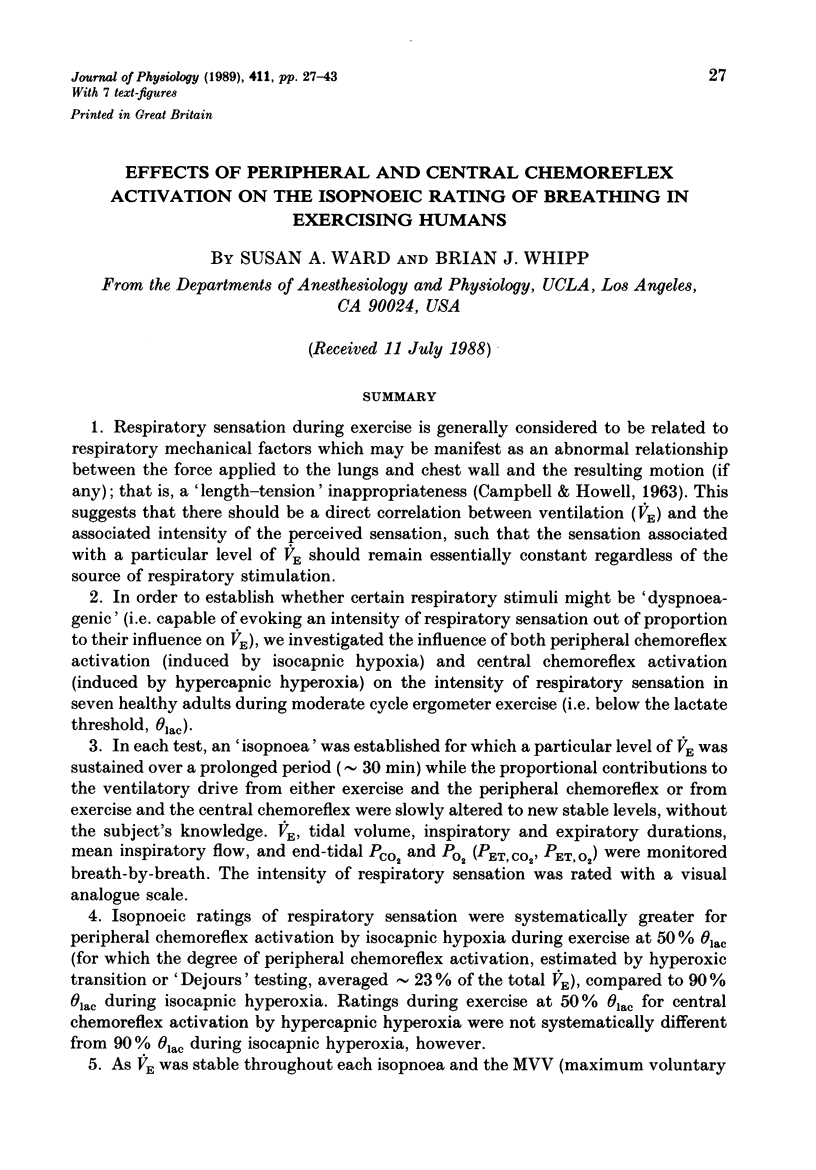
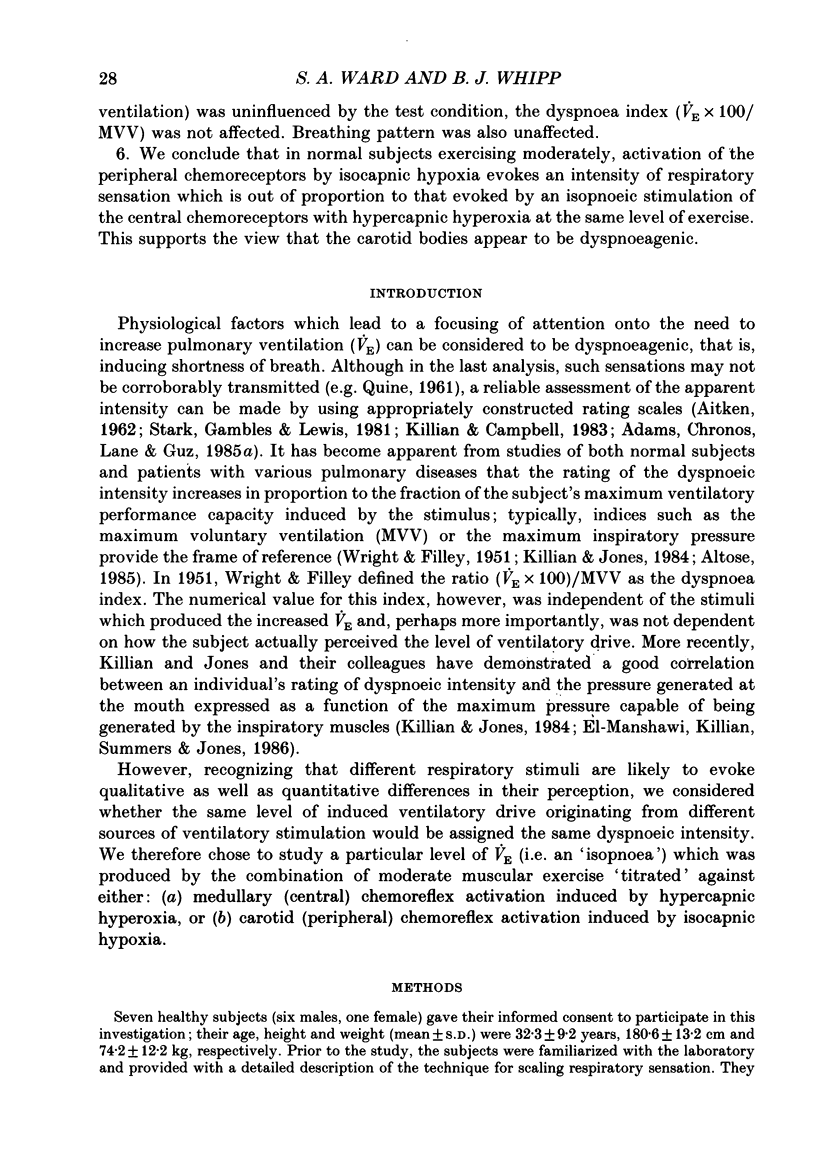
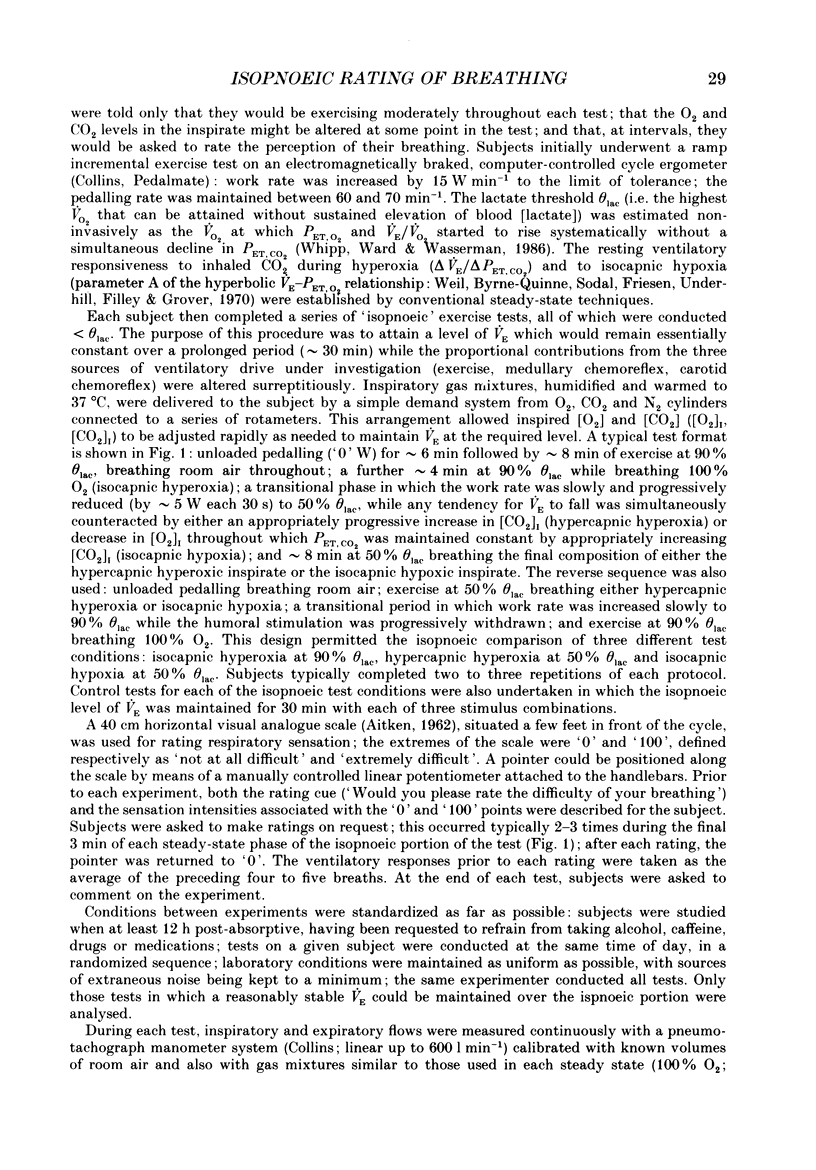
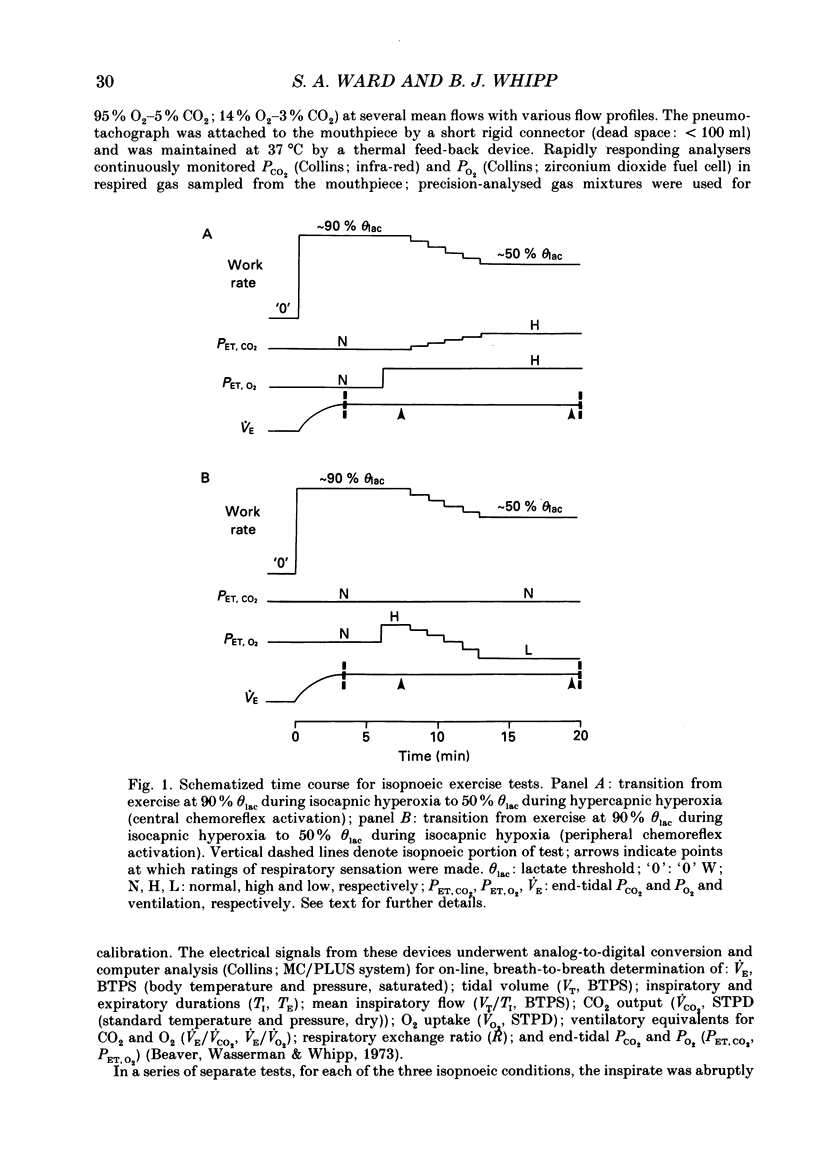
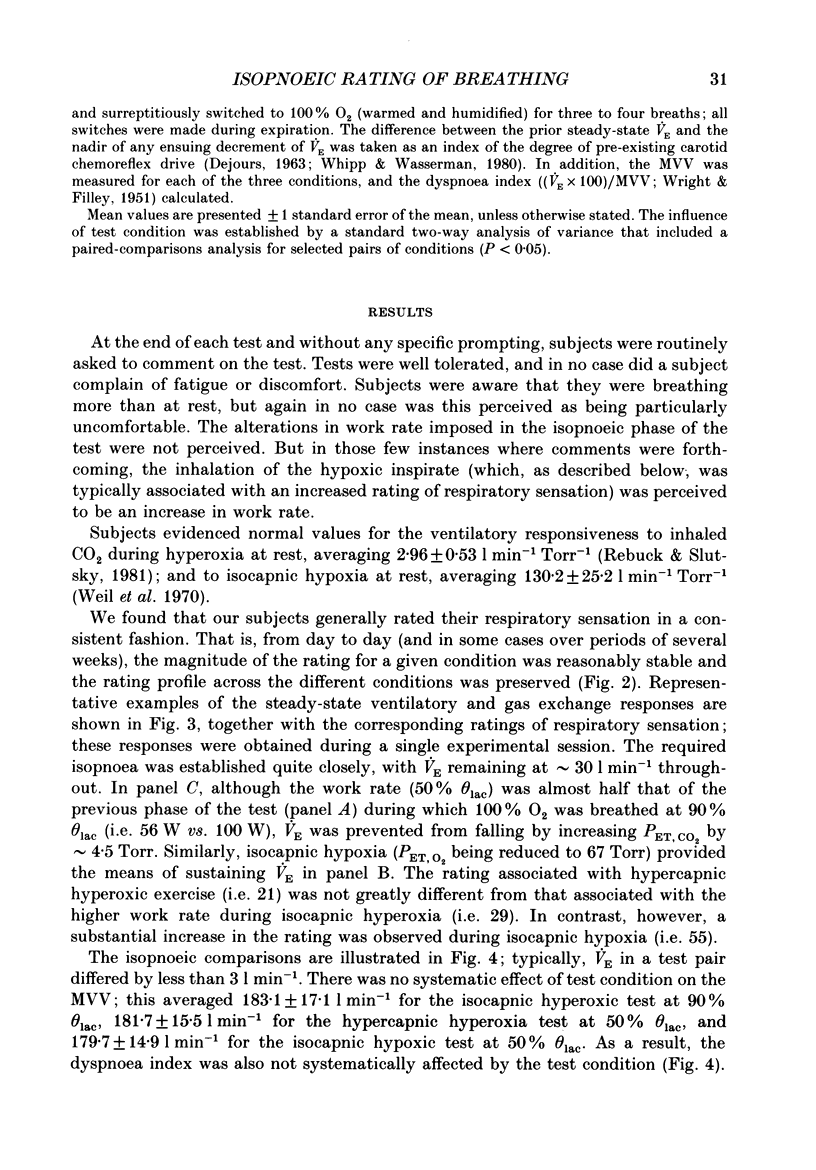
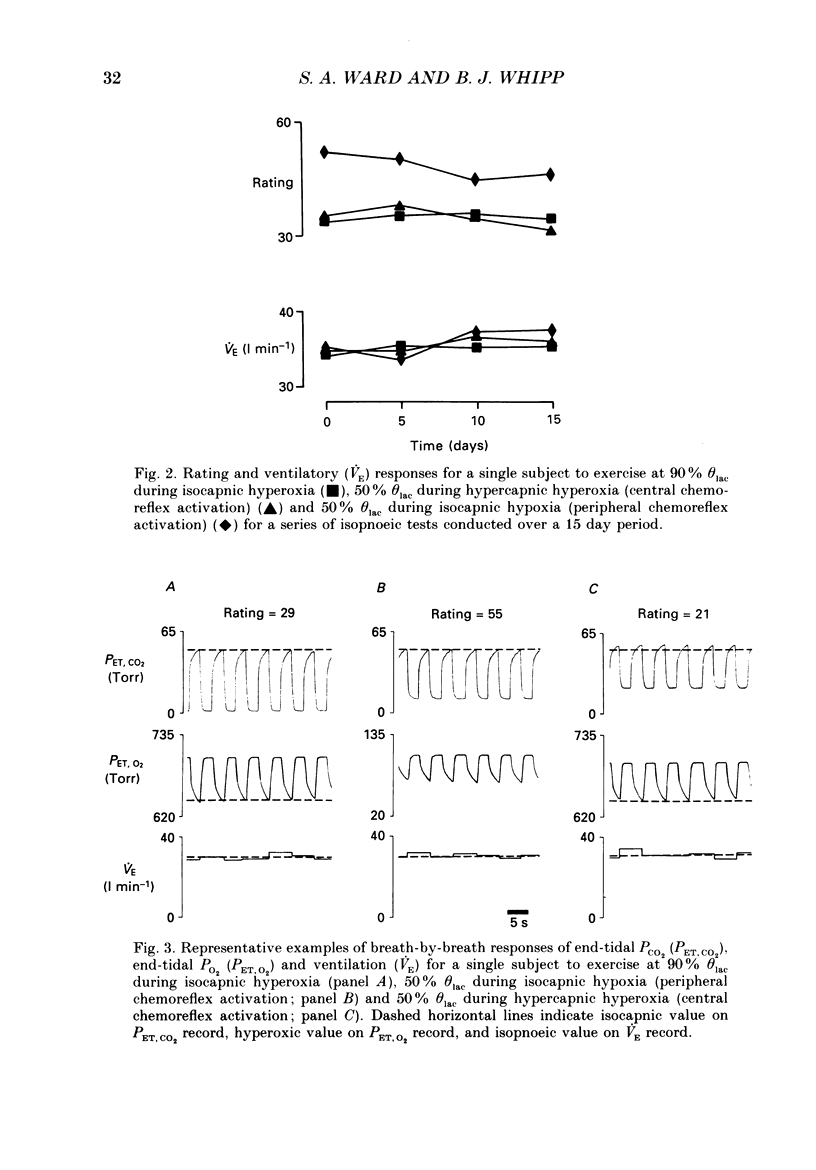
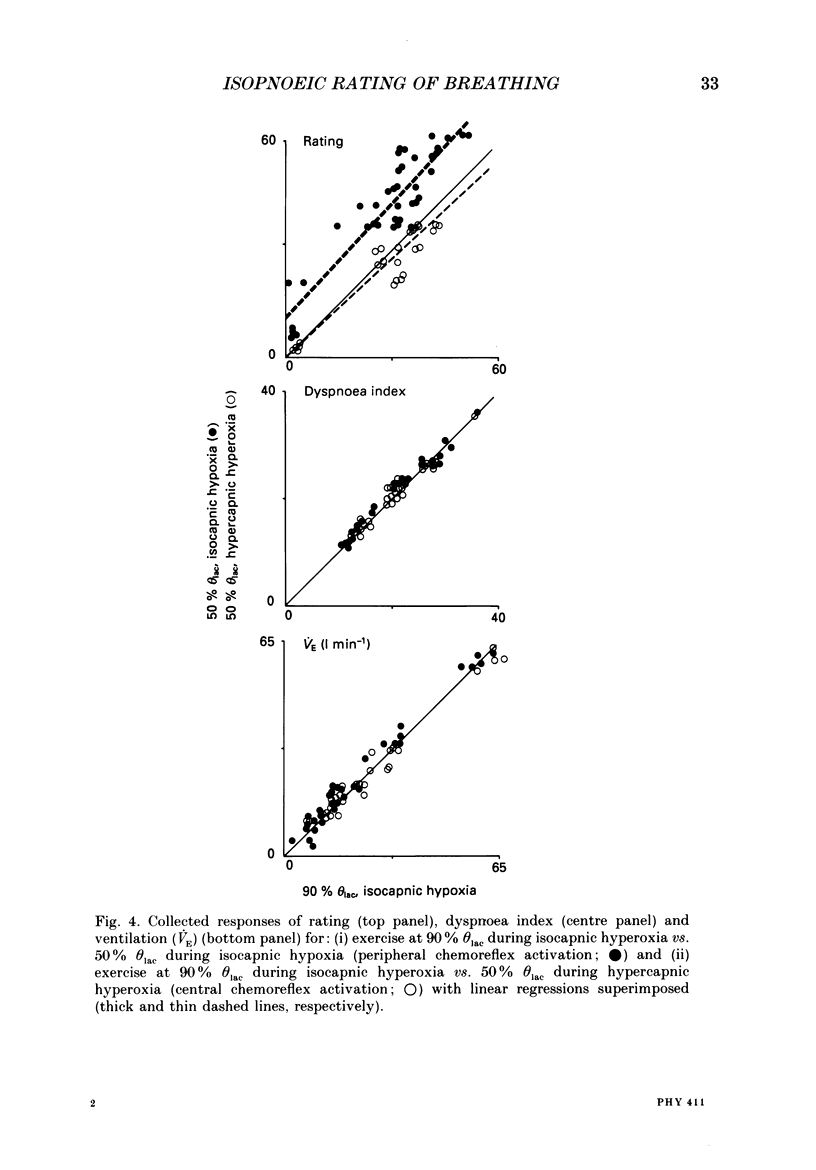
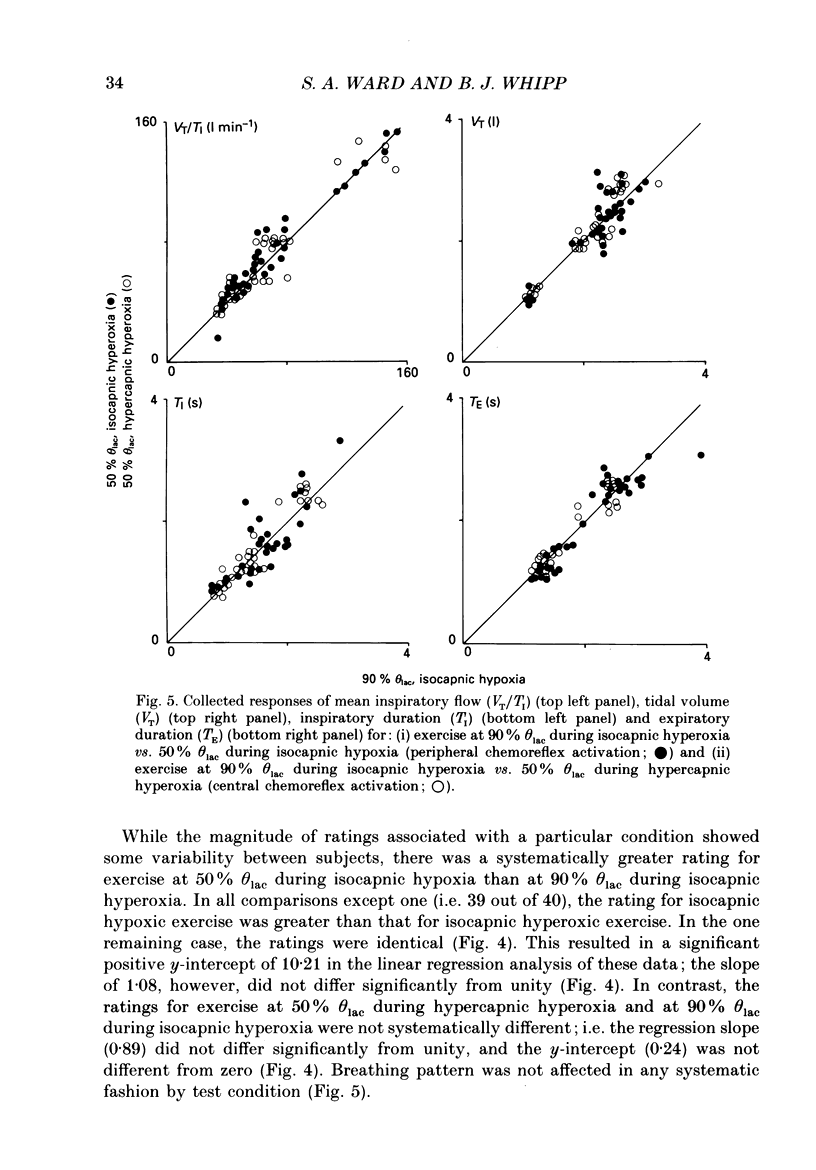
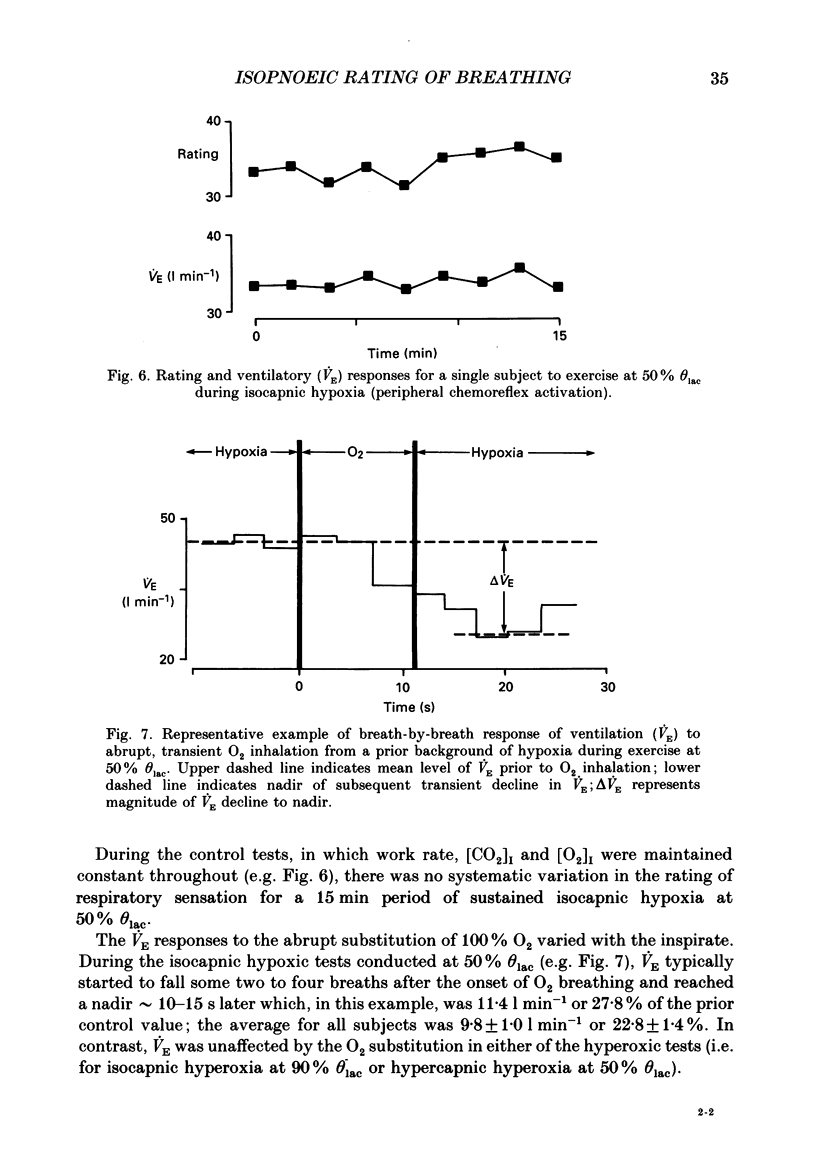
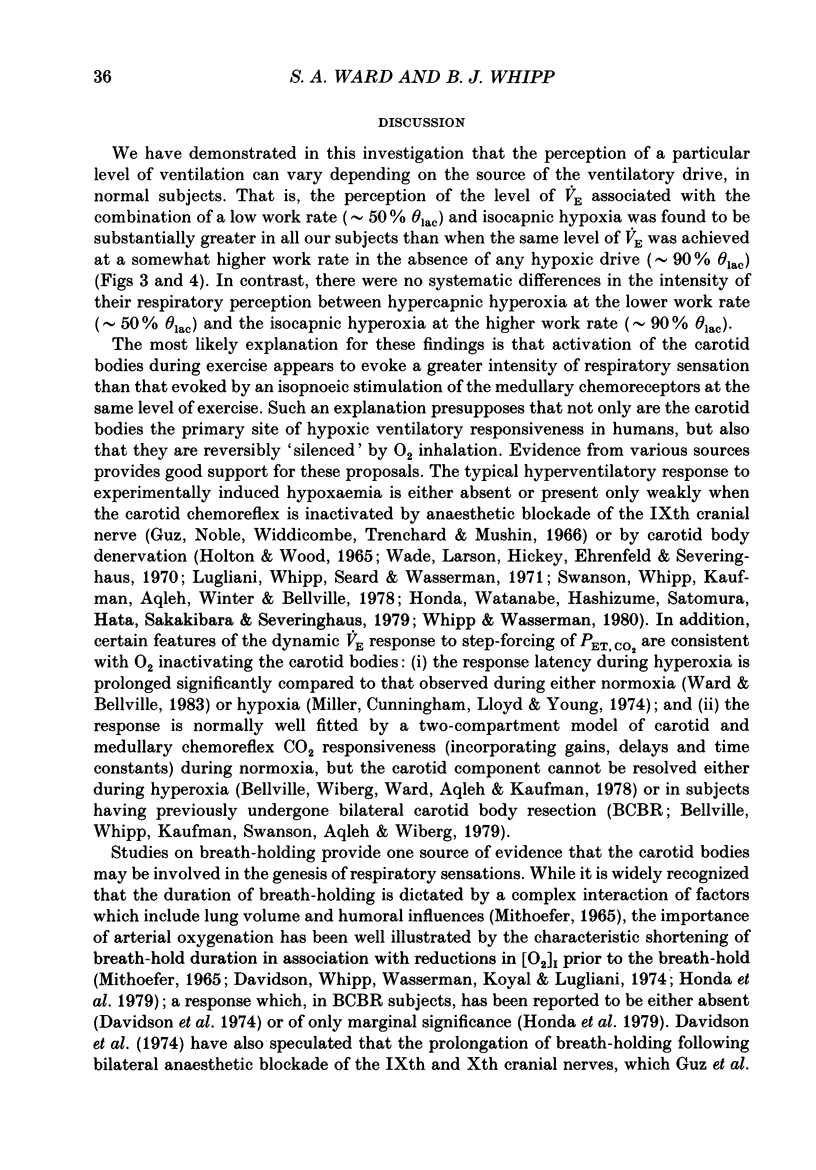
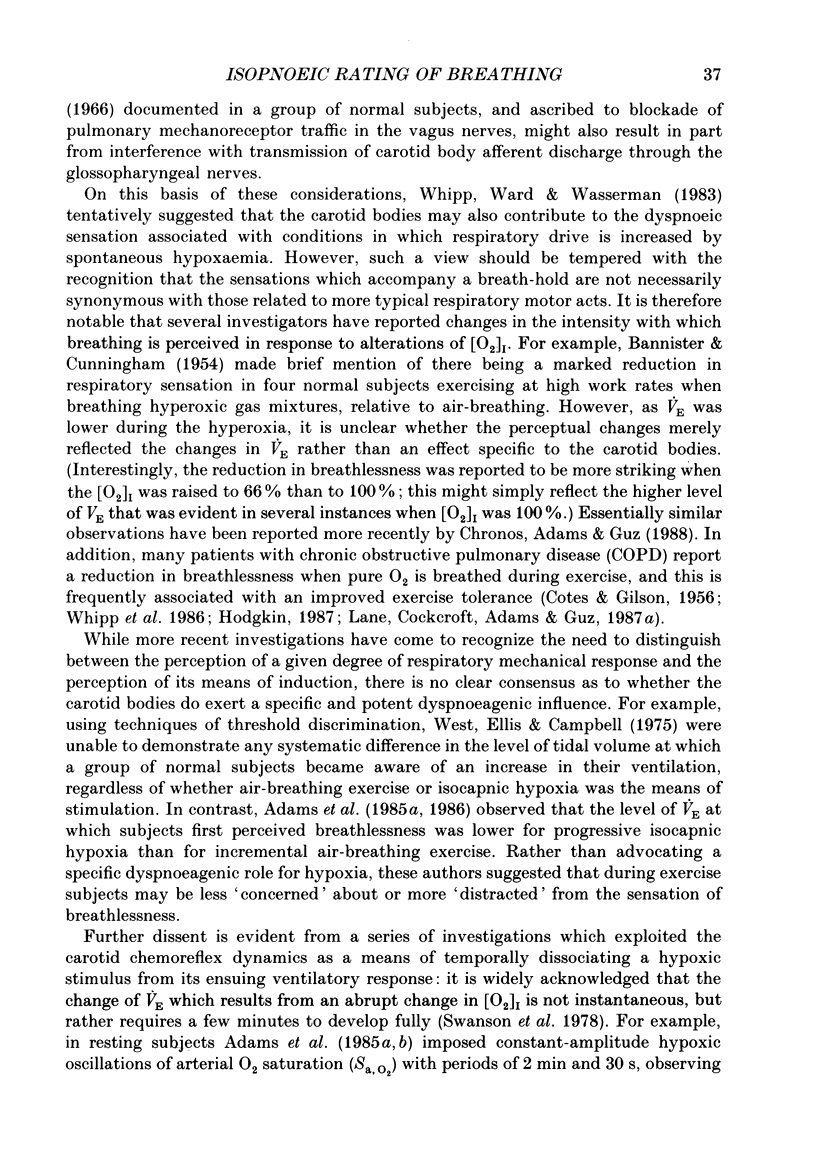
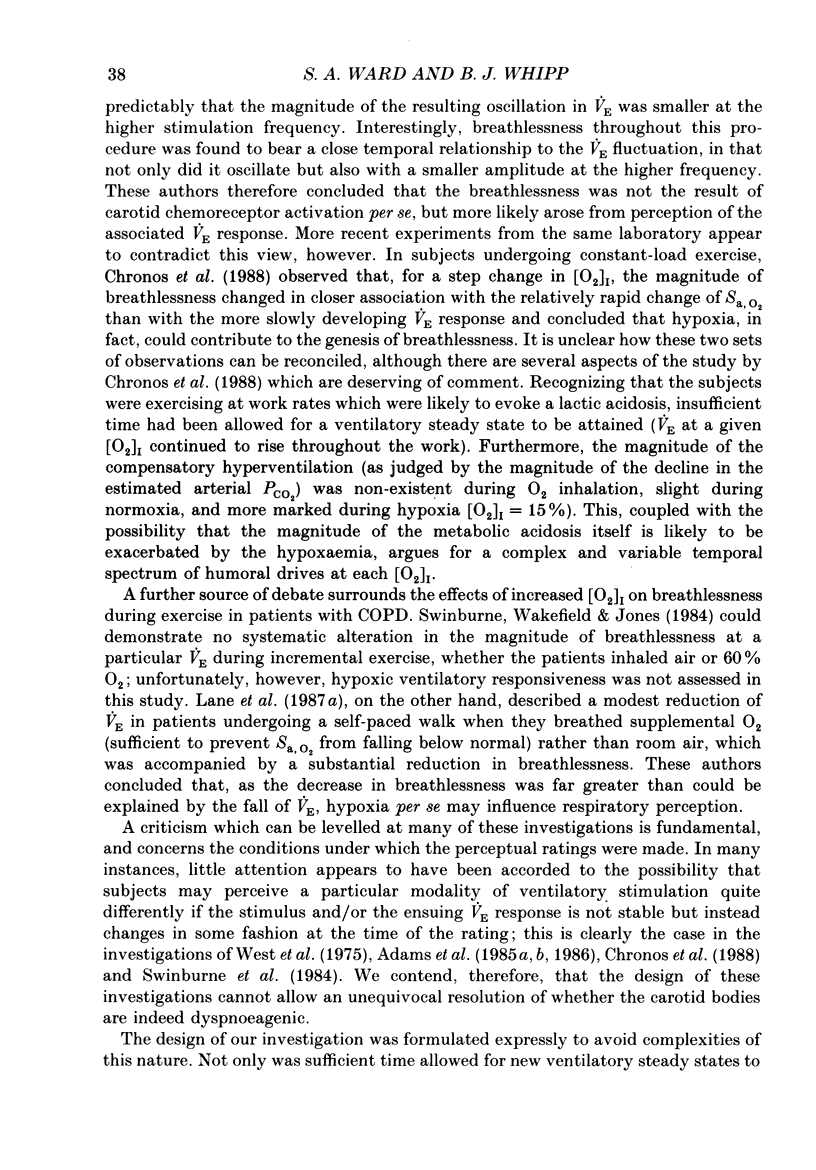
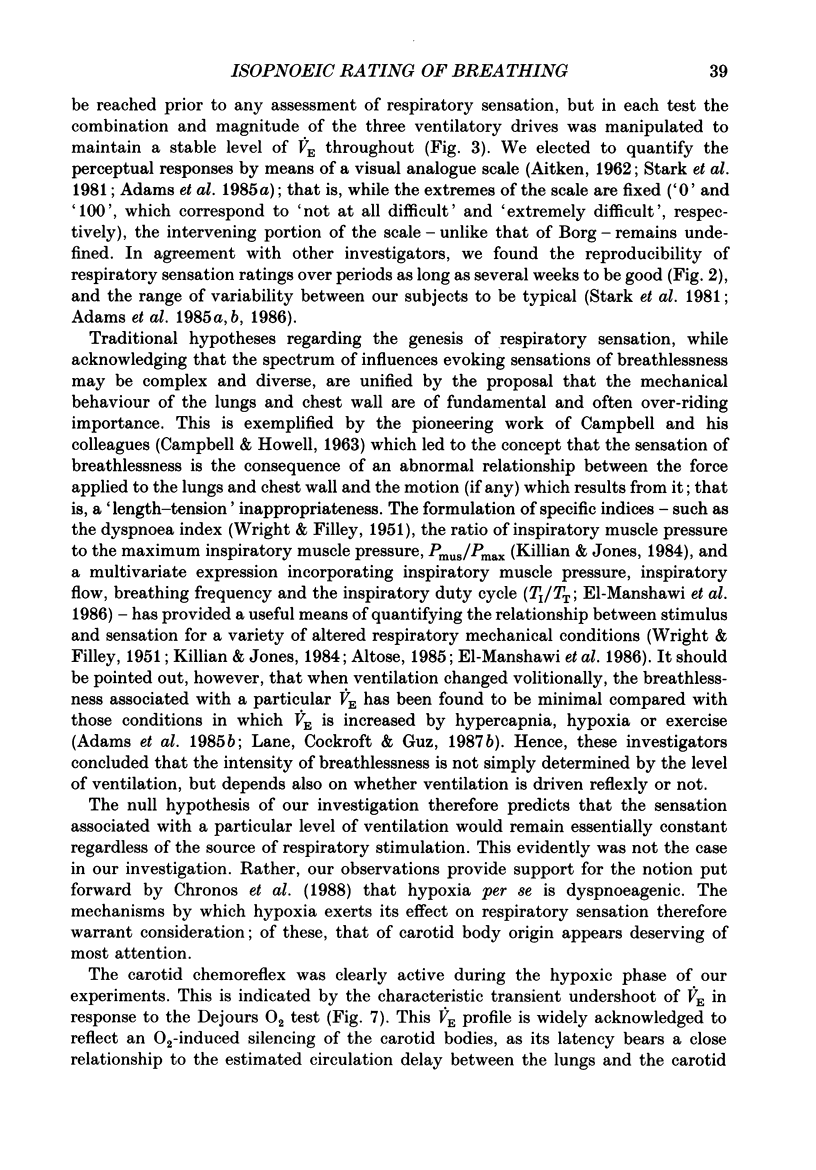
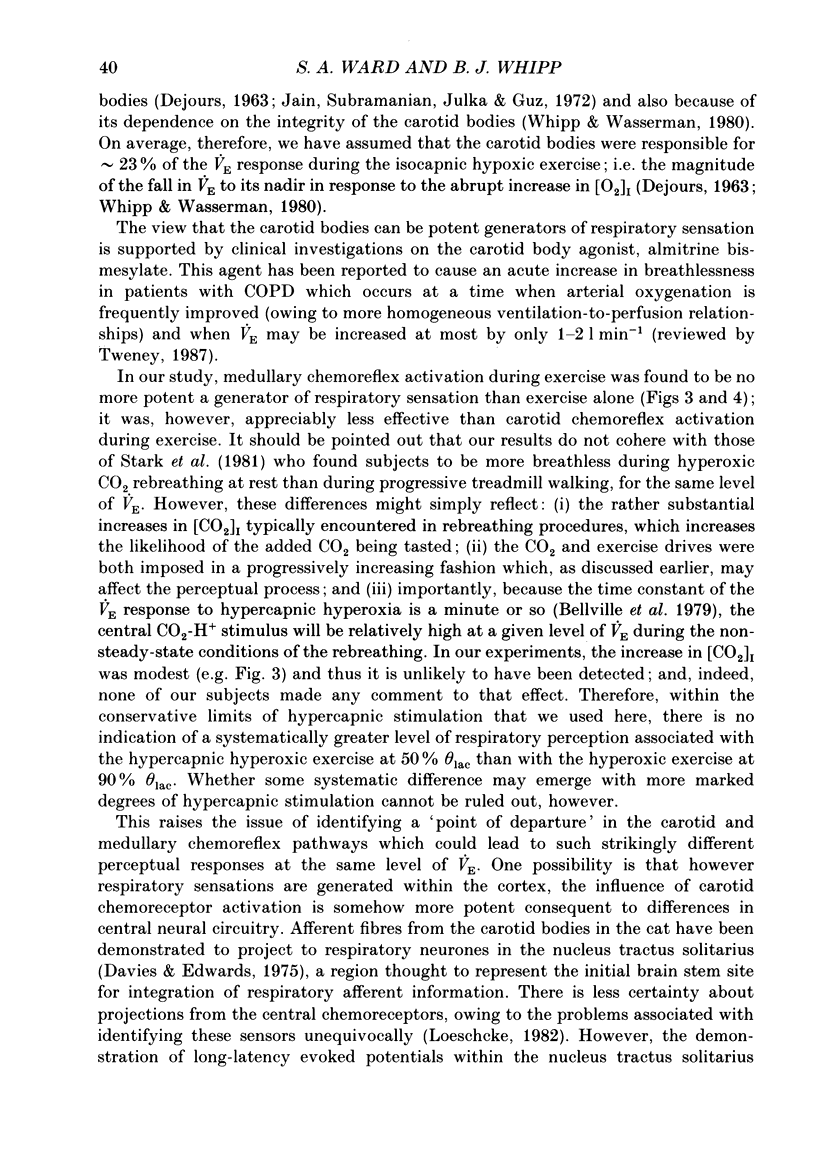
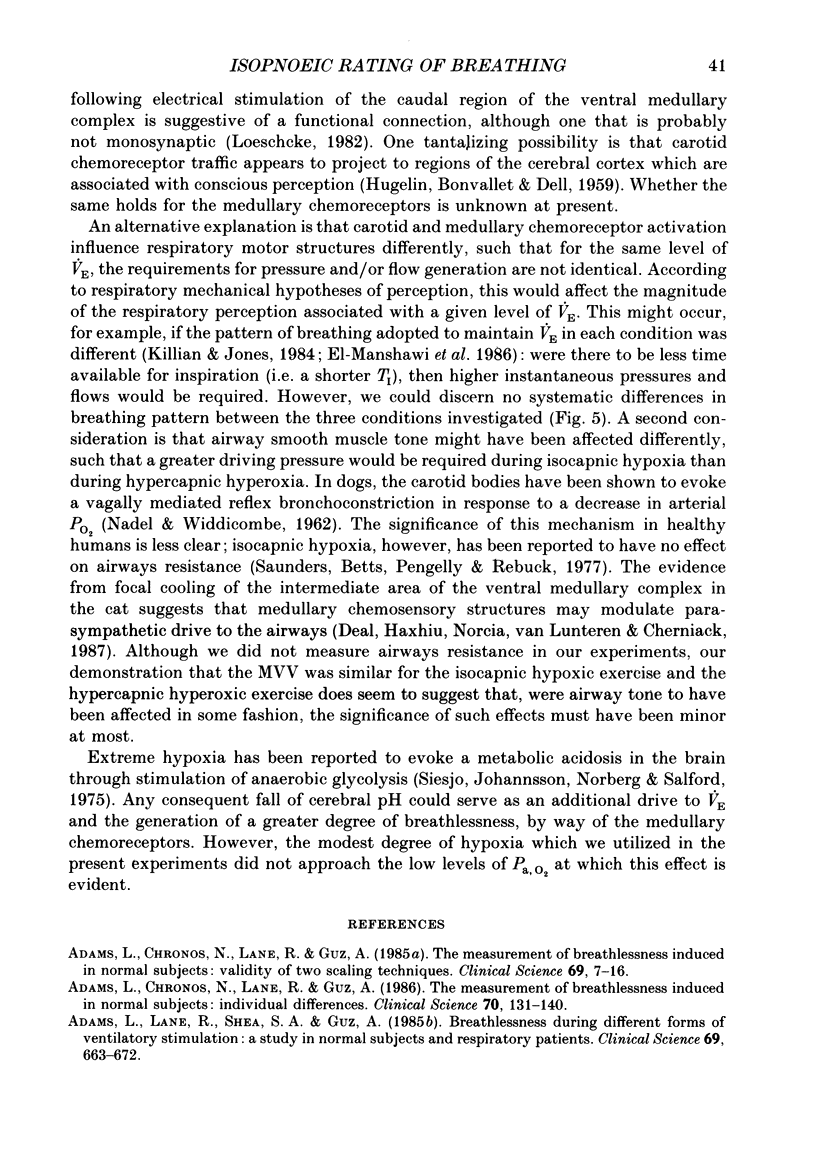
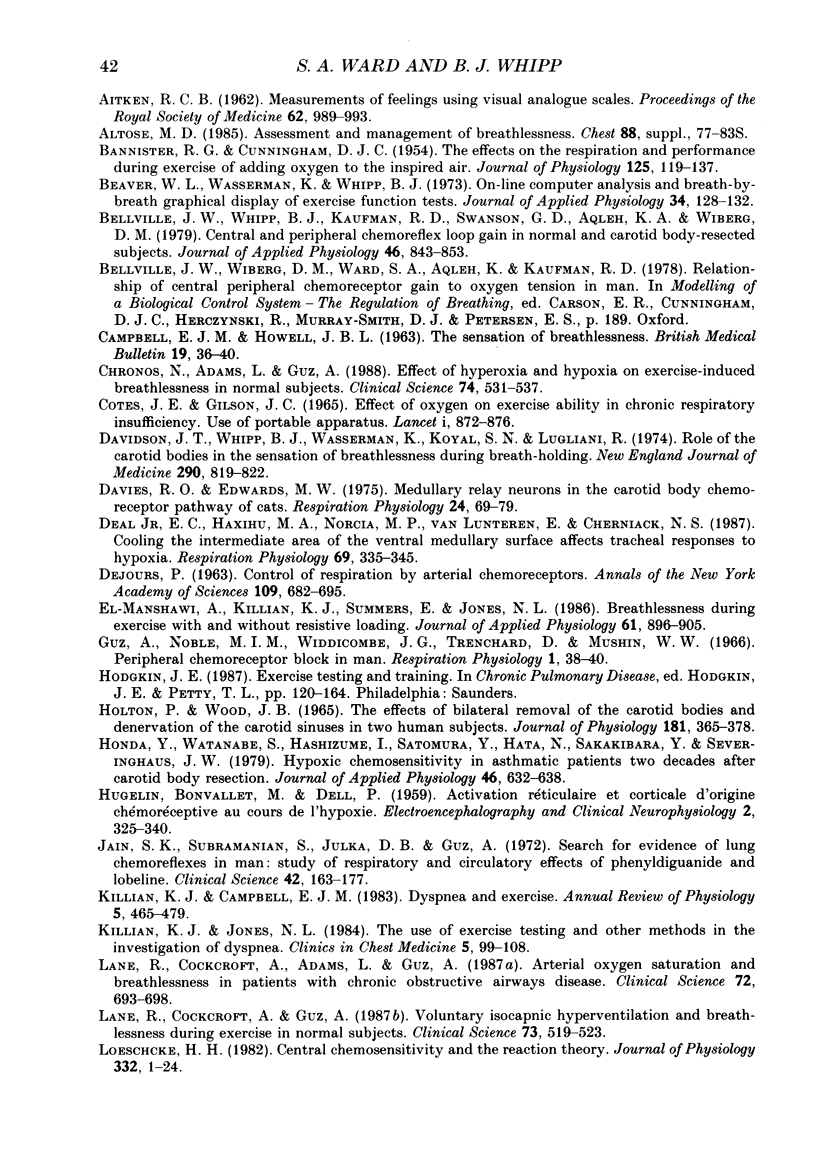
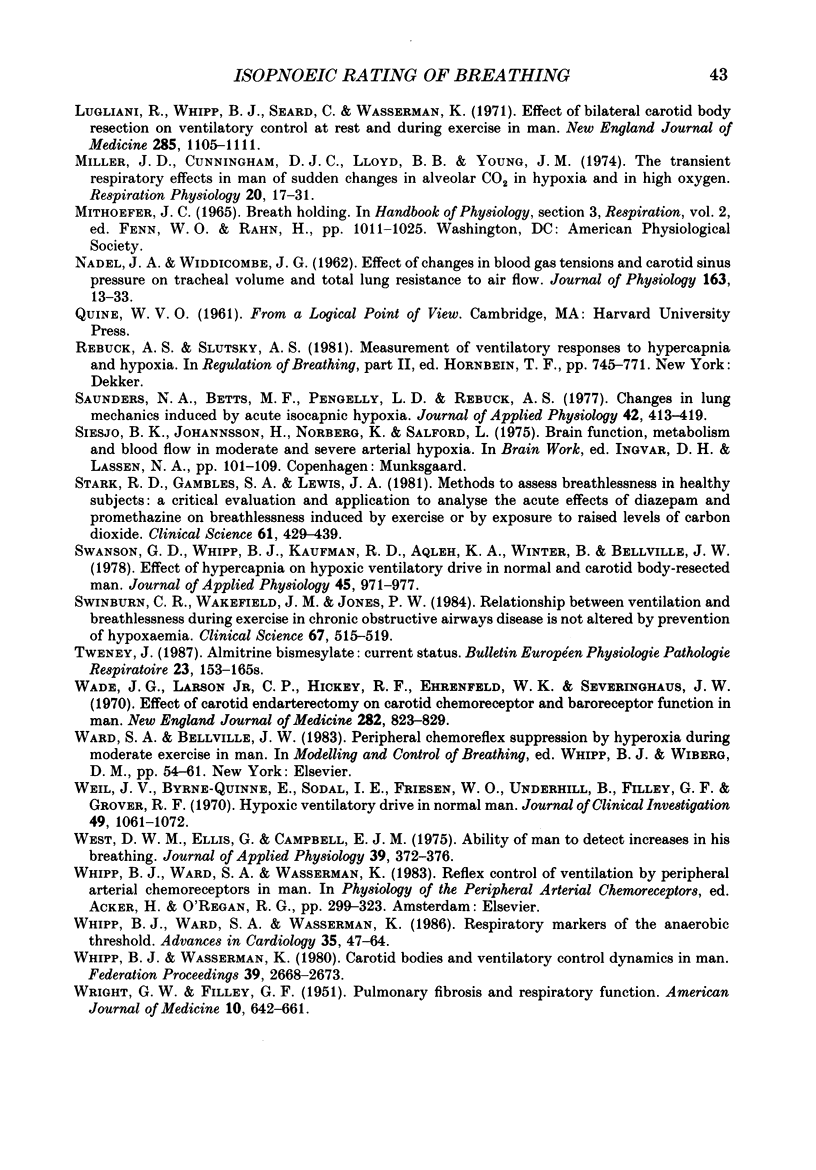
Selected References
These references are in PubMed. This may not be the complete list of references from this article.
- Adams L., Chronos N., Lane R., Guz A. The measurement of breathlessness induced in normal subjects: individual differences. Clin Sci (Lond) 1986 Feb;70(2):131–140. doi: 10.1042/cs0700131. [DOI] [PubMed] [Google Scholar]
- Adams L., Chronos N., Lane R., Guz A. The measurement of breathlessness induced in normal subjects: validity of two scaling techniques. Clin Sci (Lond) 1985 Jul;69(1):7–16. doi: 10.1042/cs0690007. [DOI] [PubMed] [Google Scholar]
- Adams L., Lane R., Shea S. A., Cockcroft A., Guz A. Breathlessness during different forms of ventilatory stimulation: a study of mechanisms in normal subjects and respiratory patients. Clin Sci (Lond) 1985 Dec;69(6):663–672. doi: 10.1042/cs0690663. [DOI] [PubMed] [Google Scholar]
- Aitken R. C. Measurement of feelings using visual analogue scales. Proc R Soc Med. 1969 Oct;62(10):989–993. [PMC free article] [PubMed] [Google Scholar]
- BANNISTER R. G., CUNNINGHAM D. J. The effects on the respiration and performance during exercise of adding oxygen to the inspired air. J Physiol. 1954 Jul 28;125(1):118–137. doi: 10.1113/jphysiol.1954.sp005145. [DOI] [PMC free article] [PubMed] [Google Scholar]
- Beaver W. L., Wasserman K., Whipp B. J. On-line computer analysis and breath-by-breath graphical display of exercise function tests. J Appl Physiol. 1973 Jan;34(1):128–132. doi: 10.1152/jappl.1973.34.1.128. [DOI] [PubMed] [Google Scholar]
- Bellville J. W., Whipp B. J., Kaufman R. D., Swanson G. D., Aqleh K. A., Wiberg D. M. Central and peripheral chemoreflex loop gain in normal and carotid body-resected subjects. J Appl Physiol Respir Environ Exerc Physiol. 1979 Apr;46(4):843–853. doi: 10.1152/jappl.1979.46.4.843. [DOI] [PubMed] [Google Scholar]
- CAMPBELL E. J., HOWELL J. B. The sensation of breathlessness. Br Med Bull. 1963 Jan;19:36–40. doi: 10.1093/oxfordjournals.bmb.a070002. [DOI] [PubMed] [Google Scholar]
- Chronos N., Adams L., Guz A. Effect of hyperoxia and hypoxia on exercise-induced breathlessness in normal subjects. Clin Sci (Lond) 1988 May;74(5):531–537. doi: 10.1042/cs0740531. [DOI] [PubMed] [Google Scholar]
- DEJOURS P. Control of respiration by arterial chemoreceptors. Ann N Y Acad Sci. 1963 Jun 24;109:682–695. doi: 10.1111/j.1749-6632.1963.tb13497.x. [DOI] [PubMed] [Google Scholar]
- Davidson J. T., Whipp B. J., Wasserman K., Koyal S. N., Lugliani R. Role of the carotid bodies in breath-holding. N Engl J Med. 1974 Apr 11;290(15):819–822. doi: 10.1056/NEJM197404112901502. [DOI] [PubMed] [Google Scholar]
- Davies R. O., Edwards M. W., Jr Medullary relay neurons in the carotid-body chemoreceptor pathway of cats. Respir Physiol. 1975 Jun;24(1):69–79. doi: 10.1016/0034-5687(75)90122-x. [DOI] [PubMed] [Google Scholar]
- Deal E. C., Jr, Haxhiu M. A., Norcia M. P., van Lunteren E., Cherniack N. S. Cooling the intermediate area of the ventral medullary surface affects tracheal responses to hypoxia. Respir Physiol. 1987 Sep;69(3):335–345. doi: 10.1016/0034-5687(87)90087-9. [DOI] [PubMed] [Google Scholar]
- Guz A., Noble M. I., Widdicombe J. G., Trenchard D., Mushin W. W. Peripheral chemoreceptor block in man. Respir Physiol. 1966;1(1):38–40. doi: 10.1016/0034-5687(66)90027-2. [DOI] [PubMed] [Google Scholar]
- HUGELIN A., BONVALLET M., DELL P. Activation réticulaire et corticale d'origine chémoceptive au cours de l'hypoxie. Electroencephalogr Clin Neurophysiol. 1959 May;11(2):325–340. doi: 10.1016/0013-4694(59)90086-0. [DOI] [PubMed] [Google Scholar]
- Holton P., Wood J. B. The effects of bilateral removal of the carotid bodies and denervation of the carotid sinuses in two human subjects. J Physiol. 1965 Nov;181(2):365–378. doi: 10.1113/jphysiol.1965.sp007767. [DOI] [PMC free article] [PubMed] [Google Scholar]
- Honda Y., Watanabe S., Hashizume I., Satomura Y., Hata N., Sakakibara Y., Severinghaus J. W. Hypoxic chemosensitivity in asthmatic patients two decades after carotid body resection. J Appl Physiol Respir Environ Exerc Physiol. 1979 Apr;46(4):632–638. doi: 10.1152/jappl.1979.46.4.632. [DOI] [PubMed] [Google Scholar]
- Jain S. K., Subramanian S., Julka D. B., Guz A. Search for evidence of lung chemoreflexes in man: study of respiratory and circulatory effects of phenyldiguanide and lobeline. Clin Sci. 1972 Feb;42(2):163–177. doi: 10.1042/cs0420163. [DOI] [PubMed] [Google Scholar]
- Killian K. J., Campbell E. J. Dyspnea and exercise. Annu Rev Physiol. 1983;45:465–479. doi: 10.1146/annurev.ph.45.030183.002341. [DOI] [PubMed] [Google Scholar]
- Killian K. J., Jones N. L. The use of exercise testing and other methods in the investigation of dyspnea. Clin Chest Med. 1984 Mar;5(1):99–108. [PubMed] [Google Scholar]
- Lane R., Cockcroft A., Adams L., Guz A. Arterial oxygen saturation and breathlessness in patients with chronic obstructive airways disease. Clin Sci (Lond) 1987 Jun;72(6):693–698. doi: 10.1042/cs0720693. [DOI] [PubMed] [Google Scholar]
- Lane R., Cockcroft A., Guz A. Voluntary isocapnic hyperventilation and breathlessness during exercise in normal subjects. Clin Sci (Lond) 1987 Nov;73(5):519–523. doi: 10.1042/cs0730519. [DOI] [PubMed] [Google Scholar]
- Loeschcke H. H. Central chemosensitivity and the reaction theory. J Physiol. 1982 Nov;332:1–24. doi: 10.1113/jphysiol.1982.sp014397. [DOI] [PMC free article] [PubMed] [Google Scholar]
- Lugliani R., Whipp B. J., Seard C., Wasserman K. Effect of bilateral carotid-body resection on ventilatory control at rest and during exercise in man. N Engl J Med. 1971 Nov;285(20):1105–1111. doi: 10.1056/NEJM197111112852002. [DOI] [PubMed] [Google Scholar]
- Miller J. P., Cunningham D. J., Lloyd B. B., Young J. M. The transient respiratory effects in man of sudden changes in alveolar CO2 in hypoxia and in high oxygen. Respir Physiol. 1974 Feb;20(1):17–31. doi: 10.1016/0034-5687(74)90015-2. [DOI] [PubMed] [Google Scholar]
- NADEL J. A., WIDDICOMBE J. G. Effect of changes in blood gas tensions and carotid sinus pressure on tracheal volume and total lung resistance to airflow. J Physiol. 1962 Aug;163:13–33. doi: 10.1113/jphysiol.1962.sp006956. [DOI] [PMC free article] [PubMed] [Google Scholar]
- Saunders N. A., Betts M. F., Pengelly L. D., Rebuck A. S. Changes in lung mechanics induced by acute isocapnic hypoxia. J Appl Physiol Respir Environ Exerc Physiol. 1977 Mar;42(3):413–419. doi: 10.1152/jappl.1977.42.3.413. [DOI] [PubMed] [Google Scholar]
- Stark R. D., Gambles S. A., Lewis J. A. Methods to assess breathlessness in healthy subjects: a critical evaluation and application to analyse the acute effects of diazepam and promethazine on breathlessness induced by exercise or by exposure to raised levels of carbon dioxide. Clin Sci (Lond) 1981 Oct;61(4):429–439. doi: 10.1042/cs0610429. [DOI] [PubMed] [Google Scholar]
- Swinburn C. R., Wakefield J. M., Jones P. W. Relationship between ventilation and breathlessness during exercise in chronic obstructive airways disease is not altered by prevention of hypoxaemia. Clin Sci (Lond) 1984 Nov;67(5):515–519. doi: 10.1042/cs0670515. [DOI] [PubMed] [Google Scholar]
- WRIGHT G. W., FILLEY G. F. Pulmonary fibrosis and respiratory function. Am J Med. 1951 May;10(5):642–661. doi: 10.1016/0002-9343(51)90333-6. [DOI] [PubMed] [Google Scholar]
- Wade J. G., Larson C. P., Jr, Hickey R. F., Ehrenfeld W. K., Severinghaus J. W. Effect of carotid endarterectomy on carotid chemoreceptor and baroreceptor function in man. N Engl J Med. 1970 Apr 9;282(15):823–829. doi: 10.1056/NEJM197004092821501. [DOI] [PubMed] [Google Scholar]
- Weil J. V., Byrne-Quinn E., Sodal I. E., Friesen W. O., Underhill B., Filley G. F., Grover R. F. Hypoxic ventilatory drive in normal man. J Clin Invest. 1970 Jun;49(6):1061–1072. doi: 10.1172/JCI106322. [DOI] [PMC free article] [PubMed] [Google Scholar]
- West D. W., Ellis C. G., Campbell E. J. Ability of man to detect increases in his breathing. J Appl Physiol. 1975 Sep;39(3):372–376. doi: 10.1152/jappl.1975.39.3.372. [DOI] [PubMed] [Google Scholar]
- Whipp B. J., Ward S. A., Wasserman K. Respiratory markers of the anaerobic threshold. Adv Cardiol. 1986;35:47–64. doi: 10.1159/000413438. [DOI] [PubMed] [Google Scholar]
- Whipp B. J., Wasserman K. Carotid bodies and ventilatory control dynamics in man. Fed Proc. 1980 Jul;39(9):2668–2673. [PubMed] [Google Scholar]
- el-Manshawi A., Killian K. J., Summers E., Jones N. L. Breathlessness during exercise with and without resistive loading. J Appl Physiol (1985) 1986 Sep;61(3):896–905. doi: 10.1152/jappl.1986.61.3.896. [DOI] [PubMed] [Google Scholar]


